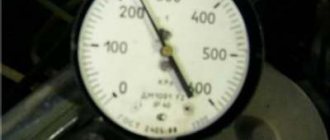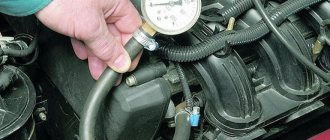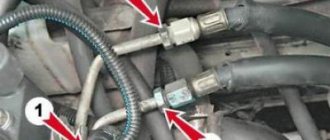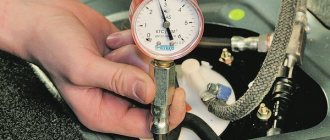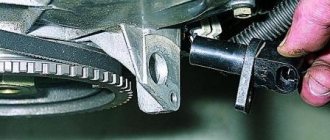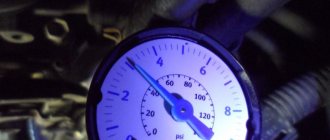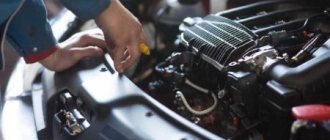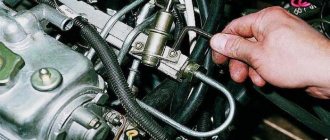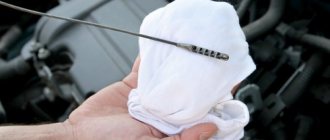Car owners are sometimes faced with the fact that there is no pressure in the fuel rail of a VAZ 2114. In order to understand the causes of this problem and how to eliminate it, it is important to understand the purpose and operating principle of this element.
VAZ fuel rail
The injection engine for the VAZ 2114 car is a power unit with distributed injection, which is carried out through injectors located on the fuel frame. What is a fuel rail? This is a hollow tube with both ends welded. The frame is attached to the engine intake manifold and has a special drain line for excess fuel.
VAZ 2114 fuel supply diagram
To maintain constant pressure in the fuel frame, the VAZ 2114 fuel pressure regulator (RDT) is designed. It is installed slightly above the ramp and has the following feature: when the power plant is stopped and the ignition is turned off, it completely shuts off the fuel supply.
At the same time, high pressure in the fuel rail is maintained for a long time, so that when the engine is turned on, gasoline enters the injectors under normal pressure and starting occurs without delay.
Design features and principle of operation
Structurally, the VAZ-2114 fuel pressure regulator is a membrane bypass valve enclosed in a metal casing. It is mounted on the ramp and inserted into it with one of the pipes through a rubber seal. The other output of the RTD is connected to the fuel line. To determine the load on the engine, the regulator is connected to the intake manifold with a vacuum hose. Thus, on the one hand, the membrane is acted upon by fuel supplied under pressure from the fuel pump, and on the other, by air pressure and the force of the valve spring.
The VAZ-2114 fuel pressure regulator has a fairly simple operating principle. When you press the accelerator pedal, excess pressure is created in the intake manifold, which opens the valve slightly, allowing more fuel into the ramp. When the throttle valve is closed, the air pressure in the intake pipe weakens. The valve opens in the other direction, releasing gasoline back into the fuel line.
When should measurements be taken?
The operation of the power system is structured as follows:
- An electric fuel pump located in the tank pumps fuel along the line into the fuel rail and further to the injectors.
- The regulator limits the gasoline pressure at a certain level, releasing excess into the tank through the return pipeline.
- The injector mixes fuel with air, then the mixture is directed to the nozzles, which open at the command of the controller.
When the wear of the regulator (abbreviated as RTD), pump or injectors reaches a critical level, the pressure in the gasoline circuit will change towards a decrease or increase. There are 2 possible scenarios: there is not enough fuel mixture for normal engine operation, or there is an excess of it - the spark plugs are literally flooded with fuel.
In both cases, checking the pressure in the fuel rail located next to the cylinder head will help identify the problem. The element is a manifold with branches for injectors, to which the main gasoline line is connected.
The fuel pressure in the manifold should be measured if the following symptoms occur:
- the car accelerates poorly, after sharply pressing the accelerator pedal, jerking and deceleration are felt;
- the engine of a loaded car “does not pull” and starts poorly when cold;
- shots are periodically heard in the exhaust manifold;
- a warm engine does not start after a short period of parking (especially in summer); the starter needs to be turned for 20–40 seconds.
The first two signs indicate a clear lack of gasoline, resulting from a drop in pressure in the ramp. The third case is unburnt fuel entering the exhaust manifold with subsequent combustion (a popping sound is heard). The fourth symptom indicates leaking injectors when the cylinders are filled with pure gasoline during parking. Until the pistons release excess fuel, the engine will not start.
We recommend: When should you change antifreeze and can you mix it?
Symptoms of RTD malfunction
A faulty VAZ-2114 fuel pressure regulator does not pose a critical threat, but its failure disrupts the stable operation of the engine. Symptoms of RTD failure may include:
- difficult starting of the power unit;
- unstable crankshaft speed at idle;
- reduction in engine power characteristics;
- loss of dynamics;
- the occurrence of “dips” when pressing the accelerator pedal;
- increase in fuel consumption.
Having discovered the listed signs of an RTD malfunction, you should diagnose the device and determine the cause of the failure.
Operating principle and typical failures
Structurally, the pump and electric motor are a single unit. Its electrical part is washed with fuel, which provides cooling, plus lubricates the surfaces that come into contact with each other.
Fuel pump VAZ 2114
There are many signs of breakdowns, which indicate a failure or malfunction in the fuel system, or more precisely the fuel pump. Almost every person is able to detect some of them:
- The engine does not start;
- When you try to start the engine, you cannot hear the electric motor;
- The engine runs intermittently;
- Jerking occurs when moving at low speed.
As for the reasons why the fuel pump fails, they may be:
- Fuse on the pump is broken;
- Failed relay;
- Failure of the pump electric drive;
- Poorly secured block masses;
- Damage to the pump itself;
- Missing or poor contacts at the motor terminals.
In fact, it is extremely rare for an electric motor to break down. This is due to the active cooling of the element by fuel, which not only cools, but also flushes all its components.
Shidron blower and mesh
But the centrifugal gate hydraulic supercharger suffers more often than others. The reason is small contaminants in the fuel, which end up inside the mechanism, rub against the structure and wear them out. The performance of the unit drops, the pressure decreases. This leads to the formation of the first signs of pump wear, operation noise increases, and the engine refuses to start. It is impractical to repair a broken pump; it must be completely replaced.
Possible malfunctions of the RTD
Considering that the design of the pressure regulator is mechanical, malfunctions in its operation can occur quite often. The most common device malfunctions include:
- weakening of the membrane spring;
- valve jamming;
- regulator clogging;
- violation of the tightness of the junction of the regulator and the ramp body.
When the diaphragm spring weakens, the valve cannot cope with the air pressure coming from the intake manifold. As a result, the pressure and amount of incoming fuel are reduced.
Valve jamming leads to an uncontrolled supply of fuel to the manifold and its “waste” into the fuel line. In this case, gasoline consumption increases, and the engine stops starting normally due to interruptions in the fuel supply.
Similar signs of malfunction can be observed when the regulator is clogged. Dirt and deposits reduce the throughput of the system, as a result of which the fuel pressure decreases significantly, the engine “chokes”, and normal idle speed disappears.
If the seal between the regulator and the ramp is broken, the air pressure may drop, which again will lead to a decrease in fuel pressure.
Symptoms of a problem
As a rule, checking the pressure in the fuel rail is required in the following cases:
- If malfunctions occur in the operation of the power unit at XX. In such a situation, the car may stall at the most unpredictable moment (even at a traffic light);
- the motor begins to stall, obvious instability appears in its operation;
- Significant excessive consumption of gasoline is noticeable. Consumption can generally increase by 30-50%;
- the volume of carbon monoxide in the exhaust increases.
This problem may “pop up” during inspection at stationary points and lead to a serious fine.
Please note that the symptoms we mentioned can also be caused by other problems - a clogged filter in the fuel system, a defect (malfunction) of spark plugs, bad fuel, and so on.
But if the initial inspection does not produce results, and the ECU does not generate errors, then checking the pressure in the ramp is mandatory.
What you need to check the pressure in the system
In order to verify the serviceability (malfunction) of the RTD, as well as the entire fuel system, it is necessary to determine the value of the fuel pressure. Naturally, you will need a special tool for this.
- a piece of high pressure hose (internal diameter 8-10 mm);
- several clamps corresponding to the diameter of the hose;
- pliers;
- screwdriver;
- nipple cap;
- fuel collection container;
- dry clean rag.
Why is a control valve needed?
The fuel supply system of most passenger cars requires continuous operation of an electric fuel pump. It constantly pumps gasoline into the fuel line and ramp, raising the pressure to the maximum (5–7 Bar depending on the brand of car). But such performance is needed only under increased load on the engine, when it develops high speeds and consumes a lot of fuel mixture. In normal mode, a fuel pressure at the injectors of 3–3.5 bar is sufficient.
The fuel pressure diaphragm valve, installed in the engine power system after the fuel pump, performs 3 main functions:
Without an RTD, the pump would “push through” the locking mechanisms of the injectors and gasoline would flow into the cylinders uncontrollably. In addition, the regulator protects the line from leaks at the connections, which will inevitably appear under the influence of strong pressure.
Pressure measurement modes
Before checking the pressure in the fuel rail, it is a good idea to find out how this process is carried out. To be able to more accurately determine a possible malfunction, pressure measurements must be carried out in several modes:
- with the ignition on (without starting the power unit);
- with the engine running at idle speed;
- with the vacuum hose disconnected from the regulator (to check the operation of the RTD);
- with a blocked fuel return hose;
- in overdrive mode.
VAZ 2114 fuel system: structure, principle of operation, causes of failure
Modern engines have replaced carburetors with injectors. The VAZ 2114 engine was no exception. His fuel pump was mounted directly into the fuel tank. Design features make it possible to create a pressure in the fuel rail of up to 8 atm, as well as to carry out work with a productivity of up to 80 liters per hour.
At the same time, the fuel pump does not like contaminants that are present in the fuel. Plus, you absolutely cannot start the engine idling if the tank is empty. A failed pump will not allow the engine to even start.
The entire fuel system of the VAZ 2114 consists of:
- Fuel module;
- Fuel filters;
- Fuel injectors;
- Fuel line;
- Fuel supply control system;
- Injector ramp.
The fuel module, in turn, includes the following units:
- Gasoline pump;
- Float;
- Fuel level sensor;
- Primary filter mesh.
How to check fuel rail pressure
The procedure for taking pressure measurements is as follows. First, connect a fuel pressure gauge to one end of the hose and secure the connection with a clamp. We unscrew the cap on the fuel rail (on the side opposite to the one where the RTD is installed). We place a container under the fitting to collect fuel. Using the nipple cap, press the central protrusion, thus releasing the fuel pressure in the system. This process is required! Next, without removing the container, unscrew the locking nipple completely.
When the remaining fuel has drained into the container, put the other end of the hose on the fitting and secure it with a clamp. Turn on the ignition and wait until the gas pump pumps fuel into the system. We check the pressure and compare it with the recommended one.
After this, we start the engine and take measurements at idle. Checking the functionality of the fuel pressure regulator is carried out with the vacuum hose disconnected from it and with the power unit running. If the pressure has increased to 3.3 kg/cm2, the regulator can be considered operational. If it has not changed, the RTD has most likely become unusable.
Similarly, we measure pressure when the return hose is closed, as well as in the gas overflow mode.
Purpose and principle of operation of the VAZ 2114 fuel rail
Injection car engines on the VAZ 2114 are power units with distributed injection, which occurs through injectors installed on the fuel rail. The ramp itself is a tube, or a hollow bar with ends welded on both sides. It is attached to the intake pipe on the engine intake manifold with two bolts. There is a separate line for draining excess fuel from the RTD into the tank.
The pressure in the VAZ 2114 fuel rail in front of the injectors is maintained by a fuel pressure regulator. The fuel pressure must always be higher than the intake manifold pressure, because otherwise the fuel from the injectors cannot be injected to create the mixture. Moreover, the pressure in the intake manifold changes depending on the speed and the driver’s work with the gas pedal. And in TR this figure should be constant - no less than 2.9 kg/sq.cm. and no more than 3.3 kg/sq.cm.
The RTD on the engine is located above the ramp, and it is structurally designed in such a way that when the power plant stops and the ignition is turned off, it closes completely and cuts off the gasoline supply. As a result, a constantly high pressure is maintained in the TP tube for a long time. Therefore, when starting, gasoline is supplied to the injectors under pressure and starting occurs without delay.
Attention! If the fuel pressure regulator is faulty, the pressure is released during prolonged parking and is insufficient for normal starting. The RDM is beyond repair and must be replaced.
The driver can become aware of the occurrence of malfunctions in the vehicle engine when the following signs appear:
- The power plant stalls at idle
- At idle the engine speed starts to fluctuate
- During the movement, unstable operation of the internal combustion engine is felt, which is expressed in floating speeds
- the engine starts to stall
- increased gasoline consumption is noticed
- When the ECU is working properly, engine power drops
- increased carbon dioxide content in the exhaust
One of the first actions that the driver must do is measure the pressure in the VAZ 2114 ramp.
Replacing the RTD
The RTD can be replaced either with the fuel rail removed or without dismantling it. The latter option is more preferable as it requires less time. But before removing the fuel rail or the regulator itself, do not forget to reduce the pressure in the system as described above! Otherwise, the entire engine compartment will be splashed with gasoline.
So, let's look at how to replace the VAZ-2114 fuel pressure regulator without dismantling the ramp. For this you will need:
- key to “10”;
- key to "17";
- key to “24”;
- hexagon to “5”;
- screwdriver with Phillips bit;
- clean dry cloth.
Which fuel pump to install on a VAZ 2114
On the VAZ 2114 and others of this family, they are installed from Bosch or Denso, since the original fuel pump only comes complete with a module (article 21102-1139009-02). Other manufacturers may be preferred only for reasons of economy.
| Manufacturer | vendor code | Average price, rub. |
| SAT 3.9 | STFP06 | 799 |
| MEAT DORIA 3.9 | 76416 | 1056 |
| DENSO 4.6 | DFP0105 | 2504 |
| BOSCH 3.8 | 580453453 | 2899 |
Work order
- First, disconnect the negative terminal from the battery (key to “10”).
- Disconnect the regulator vacuum hose from the intake manifold fitting.
- Using a “17” wrench, unscrew the nut securing the drain hose. Disconnect the hose.
- Using a Phillips screwdriver, unscrew the bolt of the return pipeline clamping plate.
- Using a hex wrench set to “5”, unscrew the screws securing the RTD to the fuel rail.
- Using a “24” wrench, unscrew the nut connecting the drain hose fitting and the RTD.
- Remove the fuel pressure regulator.
That's basically the whole process. Installation of the RTD is carried out in the reverse order. Important: do not lose the rubber seal that comes with the regulator. Without it, the connection between the RTD and the fuel rail will be leaky, which will lead to a change in the operating pressure in the system.
Troubleshooting
When the ignition is turned off, the pump does not gain the required pressure
If, when you turn on the ignition, the pressure gauge shows values below the permissible values, then the culprits may be the fuel pump itself, injectors, RTD, fuel filters and a rupture in the fuel line.
The first step is to replace all filter elements in order to eliminate them, since they are not expensive. When replacing the coarse fuel filter, you should pay attention to the corrugated tube connecting the fuel pump glass to the fuel pump for cracks and breaks. Then re-measure the fuel pressure. If replacing the filter elements does not help, move on.
Checking the fuel pump and RTD
Without removing from the tank
It is necessary to connect a device for measuring fuel pressure directly to the fuel pump glass (this can be done in 1.6-liter engines) or clamp off the return line of the fuel system (1.5-liter engine). The pressure gauge reading should increase to 6-8 bar. If the readings remain the same, then the culprit is the fuel pump. If the pressure gauge readings increase, the fuel pressure regulator should be changed.
With removal from the tank
After removing the fuel pump glass from the tank, you need to dismantle the fuel pump and check it for pressure in the “wall”. A working pump should produce 6-8 bar. If the pump gives out, the culprit will be found, if not and the pump presses 6-8 bar, then we go further and replace the RTD.
After replacing the RTD, we put the glass back in place and check the fuel pressure again. In three modes. The pressure gauge readings should be normal. If during installation on the car the pressure gauge readings dropped again, then we move on and most likely it’s the injectors.
Injectors
Injectors are the last option for fuel system pressure instability. Due to wear or contamination, they may not hold fuel pressure. The injectors need to be washed. How to properly and quickly wash the injectors with your own hands can be found in detail in our article . If washing the injectors does not help, they should be replaced.
Some useful tips
To ensure that the fuel pressure regulator does not cause you trouble and works as long as possible, use these tips.
- When planning to replace an RTD, buy only a branded device recommended by the manufacturer.
- Fill your car tank with only high-quality fuel. Do not use fuel additives of unknown origin.
- Do not forget to promptly replace the fuel filter.
- At each maintenance check the fuel pressure in the system. If problems are identified, correct them promptly.
- If you find problems with the regulator, do not delay replacing it.
The pressure in the fuel system of a modern injector is the most important performance indicator. A decrease or increase in pressure negatively affects the overall functioning and affects the behavior of the car in various driving modes. Low pressure in the system deserves special attention.
Main elements of the fuel system of an injection engine
The injector is a complex mechanism for supplying fuel to the cylinders. The entire fuel supply process is controlled by the engine's electronic control unit (ECU). The fuel supply system also uses a parallel air supply.
Fuel pump glass
The fuel pump cup is a collection of the main elements of the fuel system assembled on one site.
The fuel pump glass includes:
- Gasoline pump
- Coarse filter
- Fuel level sensor
- Fuel pressure regulator (only in 1.6 liter engine versions)
Gasoline pump
It is one of the main elements of the fuel system. Serves to supply fuel to the cylinder block under pressure. A fuel pump is a kind of electric motor. Its operation is based on the principle of centrifugal force. Under the influence of the magnetic field formed in the stator of an electric motor, its armature is given rotation. A pump volute is installed on the anchor shaft, which directly pumps pressure into the fuel system.
The gasoline pump is very capricious and picky about the purity of the fuel consumed. Most often, the fuel pump fails due to low-quality fuel or its lack in the tank. In order for the gas pump to last as long as possible, it is necessary to refuel at proven gas stations and keep at least 25% of the tank volume in the car’s tank. If you drive with the fuel light on, the fuel pump will most likely fail much faster, since if there are bumps, the gasoline in the tank will squish from side to side and the fuel pump will suck in air.
Injectors and fuel rail
The fuel rail serves as a kind of case for the injectors; it is in it that they are installed.
Fuel rail with injectors
The injectors of an injection engine are also one of the most important elements of the fuel system. Designed to supply fuel to the engine cylinder block under pressure. The injector sprays fuel into small droplets for better and easier ignition in the cylinder.
Injectors
The injector is installed directly on the car engine, namely in the cylinder head. The number of injectors depends on the number of cylinders of the car. Lada cars have 4 cylinders, therefore there will also be 4 injectors.
Injectors are also very sensitive to fuel, but are less susceptible to damage since the fuel supplied to them is filtered through 2 filters: a coarse filter and a fine filter. But more about them a little later.
Fuel pressure control
Fuel pressure regulator for 1.5 liter engine
The fuel pressure regulator (FPR) is a sensor installed on the fuel rail in 1.5-liter engine versions and installed in the tank on the fuel pump cup in 1.6-liter engine versions. It serves to ensure the required fuel pressure in the system and regulates the fuel pressure by releasing excess fuel pressure into the return line.
The RTD is a very reliable element and fails extremely rarely. The cause of its breakdown may also be poor quality fuel or the aging factor.
Fuel line
Dismantled fuel line
A fuel line is a set of fuel pipes designed to transport fuel from the tank to the internal combustion engine. The highway in Lada is located under the bottom of the car and is protected by plastic covers.
Fuel level sensor
The fuel level sensor is installed in the tank on the fuel pump glass. Serves to indicate the volume of fuel in the tank, displaying information on the instrument panel.
How to measure
ATTENTION! A completely simple way to reduce fuel consumption has been found! Don't believe me? An auto mechanic with 15 years of experience also didn’t believe it until he tried it. And now he saves 35,000 rubles a year on gasoline! Read more"
All you need is a pressure gauge, which is designed to measure tires. It just needs to be modified a little by changing the scale. It is better to measure the pressure in the injection system with a device scale showing a variation within 6-7 atm.
There are other, more advanced measuring instruments. A special tool kit with a pressure gauge, adapter and drain hose is sold at an auto parts store. Costs about 1.5 thousand rubles.
Pressure can be measured at any car service center. They will charge nothing for the service - 500-600 rubles.
Possible causes of malfunction in the operation of the RTD
The design of the fuel pressure regulator is designed in such a way that the fuel pressure in the system remains stable while the engine is stopped. However, this is not always possible to achieve. This is due to wear and tear on the valve, which over time loses its ability to hold fuel. In this regard, in order to start the engine, the driver has to turn the starter for a long time.
The most common problems with the fuel control device are the following nuances.
It is worth noting that the fuel pressure regulator most often fails due to wear. Such a breakdown occurs after 100-200 thousand kilometers. In this case, thinning or drying out of the membrane is observed. At the same time, the spring weakens, and the valve gradually wedges. If problems with the valve are observed before this point, the cause of the breakdown is poor-quality assembly or a defective part.
Car owners are sometimes faced with the fact that there is no pressure in the fuel rail of a VAZ 2114. In order to understand the causes of this problem and how to eliminate it, it is important to understand the purpose and operating principle of this element.
The injection engine for the VAZ 2114 car is a power unit with distributed injection, which is carried out through injectors located on the fuel frame. What is a fuel rail? This is a hollow tube with both ends welded. The frame is attached to the engine intake manifold and has a special drain line for excess fuel.
To maintain constant pressure in the fuel frame, the VAZ 2114 fuel pressure regulator (RDT) is designed. It is installed slightly above the ramp and has the following feature: when the power plant is stopped and the ignition is turned off, it completely shuts off the fuel supply.
At the same time, high pressure in the fuel rail is maintained for a long time, so that when the engine is turned on, gasoline enters the injectors under normal pressure and starting occurs without delay.
Signs and symptoms of low pressure in the system
Weak pressure is expressed primarily by the presence of dips. You try to accelerate, press the gas pedal, nothing happens. Stopping the engine and then starting it helps (this way the pump pumps fuel). However, after ten or fifteen kilometers the situation repeats itself.
Some drivers even change the fuel filter or pump strainer in the hope of improving the situation, but this does not help. Replacing the mesh in this case is considered as a more correct option. The fact is that the pressure can drop due to a poorly functioning pump.
If the problem is not in the mesh, then the pump itself is dying. There is another reason - it is the vacuum of the fuel tank. This is how it is checked. You need to stop the car if it starts leaking, sneezing, etc. But don't turn off the engine. Then open the tank flap and loosely close it again. Continue driving, if the dips disappear, it means there is definitely a vacuum in the tank.
The lid may not be closed at all to allow air access. When there is a vacuum it is not enough. If the problem repeats, the failures do not disappear, the fuel pump must be considered the culprit.
A clogged fuel line and a malfunction of the sensor that regulates the fuel pressure immediately before injection can also cause low pressure. To reliably verify why exactly the pressure is jumping, it is necessary to carry out competent measurements. First measure the pressure of the pump, then the lines (before and after the filter), and then directly in the ramp. Such instrumental monitoring will allow us to identify a specific cause.
This sensor is often ignored by motorists, but it is its malfunction that can lead to insufficient pressure. Symptoms of a failed sensor:
- loss of car dynamics;
- Unstable engine speed in idle mode;
- difficulty starting;
- failures;
- increased fuel consumption;
- reduction in power.
Violations with RTD occur quite often, since the design of the sensor is mechanical.
- The membrane springs weaken. As a result, the valve cannot cope with the air pressure coming from the manifold, which leads to a decrease in pressure and the amount of incoming fuel.
- The valve jams, the connections lose their tightness. Because of this, the RTD becomes clogged. In general, a stuck valve can lead to an uncontrolled flow of fuel into the manifold. Fuel consumption instantly increases, the engine stops starting normally due to interruptions.
You can verify that the RTD is faulty by determining the pressure value.
| Mode | Indicators |
| Ignition on | 2.9-3 kg/cm2 |
| Engine is running | not less than 2.5 kg/cm2 |
| Vacuum hose disconnected | 3.3 kg/cm2 |
| The return line is pinched | 7 kg/cm2 |
| Peregazovka | 2.5-3 kg/cm2 |
The pressure regulator is checked first, because it is due to its malfunction that the pressure drops. If it is in order, you need to test the operation of the pump. This is done by squeezing the fuel drain check valve.
Video: how to check fuel rail pressure
Forget about fines from cameras! An absolutely legal new product - Traffic Police Camera Jammer, hides your license plates from the cameras that are installed in all cities. More details at the link.
- Absolutely legal (Article 12.2);
- Hides from photo and video recording;
- Suitable for all cars;
- Works through the cigarette lighter connector;
- Does not cause interference to radios and cell phones.
The car is not always in good working order; it happens that it stops moving normally. The engine runs intermittently, jerks, and sometimes the car does not start at all. The cause may be a clogged fuel filter, a non-working pressure regulator, or a faulty electric pump located in the gasoline tank. To find out all these faults, you need to measure the pressure in the fuel line.
Measuring pressure in the fuel system
see also
Comments 15
My revs have been fluctuating since I bought the car. It rarely happens that the engine runs perfectly smoothly and without interruptions (this is some kind of miracle), and then this lasts no more than 1-2 minutes. And so there are always slight twitches, and the tachometer floats slightly from 840-880 rpm. Already over a distance of 216 thousand km... I tried to look for air leaks, all the hoses (especially the small ventilation of the boat, and from the absorber. Most often, everyone does not hold it tightly, the hose rotates easily.) are sealed with sealant. The rubber seals on the manifold connection were also replaced during disassembly engine. I THINK THAT THE PROBLEM LIES IN A POORLY WRITTEN PROGRAM ON THE ECU, ALTHOUGH IT IS FINE (ALTHOUGH IT IS FISHED). A friend also had a 2114 but 1.5 8V, that’s who I envied at idle speed. Well, it just worked perfectly smoothly, without any twitching. The tachometer stood dead at 860 rpm. Although the car was much older than mine. This is my opinion and what the heck...
I had a V8 converted to an indexer and a VAZ 2111, they didn’t have such a problem, so that when you press the pedal a little, the revolutions would float. There were problems with idle, but everything was solved by arranging an air leak or replacing the sensor, but here I don’t know what else could happen.
My revs have been fluctuating since I bought the car. It rarely happens that the engine runs perfectly smoothly and without interruptions (this is some kind of miracle), and then this lasts no more than 1-2 minutes. And so there are always slight twitches, and the tachometer floats slightly from 840-880 rpm. Already over a distance of 216 thousand km... I tried to look for air leaks, all the hoses (especially the small ventilation of the boat, and from the absorber. Most often, everyone does not hold it tightly, the hose rotates easily.) are sealed with sealant. The rubber seals on the manifold connection were also replaced during disassembly engine. I THINK THAT THE PROBLEM LIES IN A POORLY WRITTEN PROGRAM ON THE ECU, ALTHOUGH IT IS FINE (ALTHOUGH IT IS FISHED). A friend also had a 2114 but 1.5 8V, that’s who I envied at idle speed. Well, it just worked perfectly smoothly, without any twitching. The tachometer stood dead at 860 rpm. Although the car was much older than mine. This is my opinion and what the heck...
PRESSURE IN THE FUEL LINE VAZ 2114
The pressure in the fuel line of an injection engine is an important parameter - if it is low, normal injection by injectors into the cylinders of an internal combustion engine (ICE) will not be ensured. And its high degree is also dangerous - fuel can flood the entire engine compartment, and then a fire will occur.
Car owners may have a question about how to check the pressure in the fuel rail, within what limits should the readings be, what is used to check it, and how to determine what may be faulty in the fuel line? So, in order.
VEHICLE DIAGRAM
First you should know how the fuel system (TS) works and what elements it consists of. The vehicle includes (elements in order, starting from gasoline intake to its direct injection):
- Gas tank (in the VAZ model 2114 it is located under the bottom of the trunk);
- Electric fuel pump (located in the gas tank);
- Coarse filter (represents a mesh that is located on the intake part of the pump);
- Fine filter (located immediately after the gas tank, located below the trunk, between the rear of the muffler and the fuel tank);
- Fuel rail or rail (TR), it distributes gasoline among the cylinders, it can be steel, aluminum or plastic;
- Injectors (there are four on model 2114);
- Fuel pressure regulator (it maintains the required gasoline pressure in the system for normal injection through the injectors into the cylinder).
All elements are connected to each other by a fuel line, and in the entire chain, after the pressure regulator (RDT), there is also a return hose through which excess gasoline is discharged into the tank. After the ignition is turned on, fuel passes through the system to the injectors (therefore, there is pressure in the system even when the ignition is on), and when the engine starts, the electronics send a command to the injectors, and gasoline enters the cylinders.
HOW AND WHAT TO CHECK THE PRESSURE IN THE VEHICLE
They check the pressure in the fuel rail of the VAZ 2114 with a pressure gauge - it is most convenient to connect it on the ramp, and not somewhere else in the line. At the rear of the ramp, in the direction of travel of the car, there is a fitting with a thread and a valve, closed with a plastic cap. When measuring, the pressure gauge adapter is screwed onto the fitting. The pressure gauge is easy to assemble yourself. For this you will need:
- The measuring device itself with an arrow - a tire pressure gauge with a maximum reading limit of 6 to 10 kgf/cm² is suitable;
- A piece of gasoline hose 50-70 cm long;
- A fitting for checking the pressure, which will be screwed into the ramp;
- Two clamps.
We assemble all the elements, tighten the clamps, and the pressure gauge is ready for use. That's it, now you can take measurements. To do this you will need tools:
- Wheel valve cap.
- Thin screwdriver or metal pin;
- A wrench with a fitting size (usually 17 mm):
- Pressure gauge.
To measure the pressure in the fuel rail, you need to:
- Turn off the engine, turn off the ignition;
- unscrew the cap, relieve pressure in the VAZ 2114 fuel rail by pressing the valve with a thin screwdriver;
- Unscrew the spool with the valve using the wheel valve cap. A rag will come in handy - when you dump it, fuel will spray out of the valve. To relieve pressure, you need to press the valve smoothly, releasing the pressure;
- secure the pressure gauge fitting with a wrench to the rail. Now you can start the internal combustion engine and measure the pressure in the fuel rail.
Fuse
Fuse 15 A
One of the final stages of checking a malfunctioning fuel pump is its fuse. Like the relay, the fuse can be seen from the inside. Or you can climb in from the outside, through the hood. Under the hood, closer to the windshield, there will be a dark box, right on the electronic control unit. You need to open it and find the topmost fuse with a current of 15 A and the English inscription fuel pump. We take it out and look at the insides: the contact is not damaged - the fuse is alive. The contact is damaged (blown) - you need to install a new fuse. As with the price of the relay issue, buying and replacing a fuse will not be a big waste of money and time.
Not every master's hands grow from the right place. For this reason. The reason that the fuel pump does not pump can be simple stupid shortcomings of simple tuning.
For example, the alarm was installed in such a way that all the contacts were mixed up, and power simply does not go to the fuel pump. Not because the alarm should not be on the car, or the wiring system is acting up, it’s just that the person who installed it didn’t have enough brains and practice. Check all connections carefully if you decide to add some style to your little one.
Or anti-theft. The button is placed in such a way that it interrupts the integrity of the fuel pump ground contact system, and almost always fails. By the way, if you have such a lotion, I don’t think it will be very effective in the absence of a signal. And if there is a signaling system, then anti-theft is not needed at all.
In any case, remember: in any situation where a VAZ breaks down, the point is not that it is a VAZ, and it was made poorly. It’s just that the Russian auto industry is a little more delicate than the foreign one, it requires a little more attention and your ingenuity.

